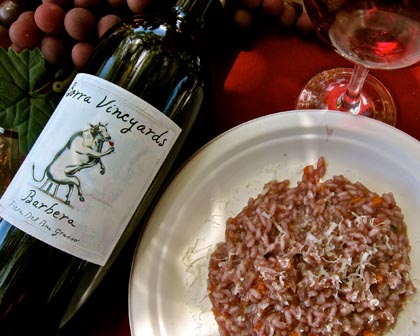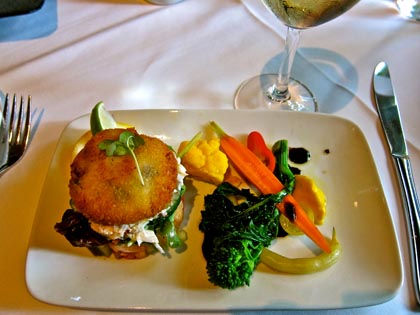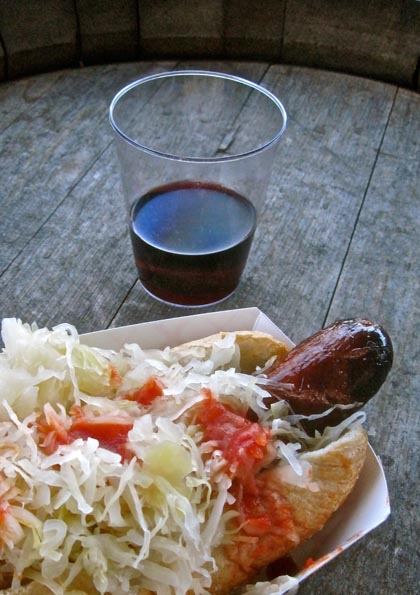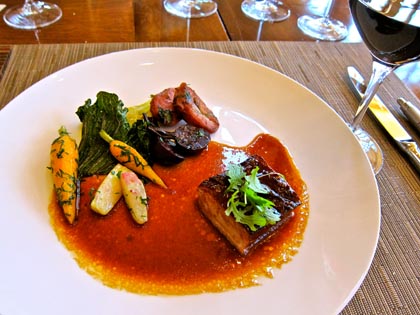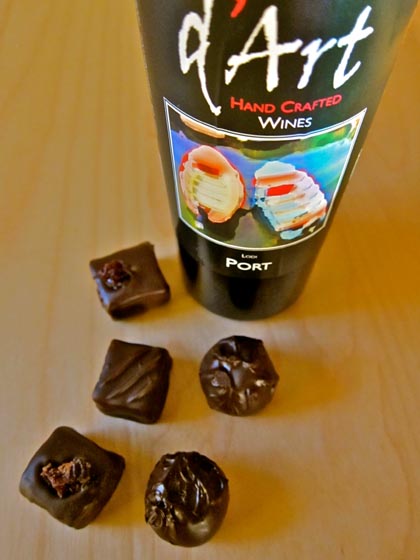Letters from Lodi
An insightful and objective look at viticulture and winemaking from the Lodi
Appellation and the growers and vintners behind these crafts. Told from the
perspective of multi-award winning wine journalist, Randy Caparoso.
Wine-food matching made easy
Commonsense contemporary match: zesty, earthy Barbera with zesty, earthy risotto soaked in wine with shaved Parmigiano
A commonsense approach to wine and food matching
We’ve mentioned some commonsense wine and food matches; like the fact that zesty, dry white wines like Sauvignon Blanc are as natural with white fish as a squeeze of fresh lemon. Or the fact that it makes sense to serve a full bodied, full tannin red wine like Cabernet Sauvignon with full, fatty red meats such as beef and lamb. It doesn’t take a Master Sommelier to understand these things. If you know that ketchup tastes good on a hamburger, and that hot fudge tastes great over vanilla ice cream, then you can easily get to know what wines make the most sense for just about any dish.
The intelligent approach to grasping how wines and foods are matched is in two different ways:
- Similarities
- Contrasts
Lemony crisp Sauvignon Blanc makes sense with dungeness crab cake, naturally enhanced by squeezes of fresh lemon
That is to say, similarities between the taste components in the wines and ingredients in a dish, and contrasts between the taste components in the wines and ingredients in a dish. As long as there is some positive interaction of sensations involving contrast and/or similarity, a wine and dish will complement each other. This is why it’s important to know the basic taste components and flavor profiles of wine grapes.
Hot zesty dogs make sense with zesty zins
A plate of raw oysters, for instance, loves the contrasting taste of lemon to bring out the flavor; so it makes sense that a plate of oysters is immensely improved by the contrasting taste of a white wine with lemony crisp acidity such as a Sauvignon Blanc, Albariño or Pinot Grigio, or even a dry Champagne style sparkler.
A more complex white fish dish served in a buttery, French style beurre blanc may also like the contrast of lemony dry whites. But it might be even better with a dry white wine with qualities of similarity rather than contrast, such as a soft, round, buttery textured, barrel fermented Chardonnay.
Besides palate sensations, aromas and flavors play an important part in such interactions, too. For example, a neat trick of the trade is to remember that red wines with peppery spice qualities – like Syrah, Petite Sirah, and to some extent, Pinot Noir and Zinfandel – do particularly well with red meats with balanced peppery spices (peppercorns or chile peppers) in the sauce or marinade. Or if a chef finishes a seafood dish with an aggressively herbal sauce (like tarragon butter, or a bell pepper infusion), a slightly green herbal scented Sauvignon Blanc establishes a matching similarity.
There are a numerous tried-and-true matches commonly known and loved today. A few examples that work, based upon the basic, commonsense principles of similarity and contrast:
- Full bodied, dry, richly flavorful white wines (like Chardonnay and Viognier) with “other white” meats (like pork, veal and chicken) in richly flavorful sauces
- White wines with zesty acidity (i.e. Sauvignon Blanc) with foods with a similar degree of acidity (like salads in mildly zesty vinaigrettes, or sharp cheeses like Chevrè and Feta)
- Slightly sweet yet zesty white wines (like Rieslings) with seafoods prepared with slightly sweet, sour, salty, and even spicy-hot sauces and ingredients (since sugar in wine and as a food ingredient brings contrasting balance to spicy, salty or acidic sensations)
- Soft, fluid red wines (like Pinot Noir and lighter style Zinfandels) with soft but full flavored red fish (like salmon and tuna)
- Zesty, pungent, earthy/foresty red wines (like Sangiovese, Barbera and Tempranillo) with zesty, Italian or Spanish influenced dishes (use of pasta, rice, tomato, balsamic vinegar, olive oil, garlic, and herbs like oregano and rosemary)
Caramelized pork belly is great with reds with caramelized fruit qualites like Zinfandel, Syrah and richer Pinot Noirs
- High tannin reds (like a youthful Cabernet Sauvignon) with slight bitterness or astringency with red meats prepared with slightly bitter peppercorns, vegetables, or char from wood grilling
- Bright, zesty, sweetly fruit scented red wines (like Zinfandel, Syrah and Petite Sirah) with fatty meats in zesty, sweet or even spicy sauces and marinades (re barbecued or even teriyaki style beef or pork ribs)
- Big, herbaceous, minty or cedary Cabernet Sauvignon based reds with red meats in sauces reduced with aromatic green herbs (mint, thyme, sage, etc.)
- Smoky, toasty, aggressively oaked wines (like many Chardonnays, and most ultrapremium reds) with white or red meats that are aggressively grilled, roasted or wood-smoked
- Sweet, intensely fruity whites like Muscat Blanc or Moscato with sweet fresh fruit desserts
- Sweet, full bodied wines (fortified reds like Port, or golden colored “late harvest” white wines) contrasting with salty blue cheeses (like Roquefort, Gorgonzola and Maytag Blue)
- Sweet, full bodied, fortified reds (like Port or “late harvest” Zinfandels) with bitter/sweet chocolate desserts
Our next Wine 101: What a difference a grape makes
Sweet Ports & chocolates: 'nuff said
